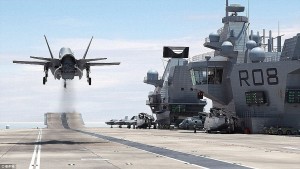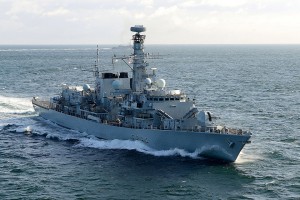2016-04-09 By Robbin Laird
In a recent UK MoD announcement concerning the UK role in Baltic defense, it was announced that RAF Typhoons will be deployed along with the HMS Iron Duke.
This is clearly designed to operate forward an to provide for NATO defense in the Baltic region.
As the F-35 comes to the force aboard the new HMS Queen Elizabeth, a future deployment to the Baltic region will actually provide for an integrated force which could form a key element for both homeland defense for the United Kingdom as well as providing core combat capabilities within an overall kill web.
Such a kill web would be empowered by a force at sea which can reach back and forward to air assets deployed throughout the region.
With the Russians deploying tactical weapons – notably cruise missiles – with reach deep into what the UK would consider strategic space, the need to deter, and defeat such threats will be increasingly important.
With the Eurofighters flying both from the UK over the North Sea, and forward deployed, and with the F-35Bs deployed off of the Queen Elizabeth, such an integrated force can be built as part of both homeland defense and an extended kill web extending into Northern Europe.
And such integration can lay the foundation for the further modernization of the UK surface fleet, as the new destroyers can deploy combat systems, which can co-evolve with those of the F-35.
Rather than thinking of the kill chain, the kill web is about engagement forces in an area of interest which can operate throughout the distributed battlespace and defeat an adversary throughout the kill area.
The sensor-shooter relationship is within the distributed battlespace and not attributed to the strike platform itself.
The idea of shift from a linear kill chain and hub-and-spoke operations to one of an distributed force contributing to capabilities across the integrated battlespace was highlighted by a key Australian RAAF leader:
According to Air Commodore Roberton, the CO of the Air Combat Group, the RAAF is going through a three-phase process and “we are only at the first step.
“We need to be in the position where our maritime surface combatants are able to receive the information that we’ve got airborne in the RAAF assets. Once they’ve got that, they’re going to actually be trying to be able to do something with it.
That is the second level, namely where they can integrate with the C2 and ISR flowing from our air fleet.
But we need to get to the third level, where they too can provide information and weapons for us in the air domain.
That is how you will turn a kill chain into a kill web. That’s something that we want in our fifth generation integrated force.
And in a fifth generation world, it’s less about who is the trigger shooter but actually making sure that everybody’s contributing effectively to the right decisions made as soon as possible at the lowest possible level.
And that is why I see the F-35 as an information age aircraft.
I’m less concerned about the load outs on the F-35. You can give it another ten weapon stations and you would miss the core point.
What’s actually important is how the F-35 makes other weapon providers or effect providers out there far better and shape faster reaction times.
A lot of people seem stuck in the old mindset of how many weapons we are going to stack on each aircraft.
That’s almost two generations ago.”
And in an interview last year with the Royal Navy officer leading the Queen Elizabeth effort, the potential for re-shaping the approach to building out the new destroyers from the evolution of a more integrated force was highlighted.
Question: We argue that no platform fights alone; this is obviously true in terms of the carrier, which is both and enabled and enabling platform, notably with regard to its carrier air wing.
What is some of the thinking in the RN about the potential evolutions?

Alcock: As I said earlier, we have not been defined by the carrier in our Navy and some of the newer assets will be rethought with the introduction of the carrier.
With the advent of the carrier we will need to re think doctrine, tactics and training.
There will be much work between elements of the CAG specifically interaction with Merlin Crows Nest and F35B but also our T45 destroyers will work extremely closely with F35B and be a great enabler in tactical development.
We need to explore the boundaries of what we can do as we leverage the carrier with regard to our other force assets, Navy, Army and Air Force.
The good thing is that a lot of people involved in the process have open minds about thinking through the process of change.
Weaponizing the kill web in which fifth generation leverages of weapons on surface and subsurface ships as well as managing hand-offs to fourth generation platforms is a key element of the way ahead.
MBDA the key weapons designer for the RAF is already developing and in the process of completing the first weapons with the kind of two way data links enabling such a handover, namely the Meteor and Spear 3 weapons.
Put in clear terms, although the UK carriers can be used for expeditionary purposes, they will provide key centerpieces for any extended defense of the homeland via modular integration with other allied forces.
These forces would be deployed as a a scalable kill web, where the sensor-shooter relationship among missile defense, and strike assets can operate in a distributed defense structure.
For the recent UK MoD announcement about Baltic operations, see the following:
https://www.gov.uk/government/news/uk-jets-and-warship-to-bolster-baltic-security
Royal Air Force Typhoon jets and the Royal Navy warship HMS Iron Duke will deploy to the Baltic this month as part of the UK’s commitment to eastern European allies.
Four Typhoons will take a leading role in the Baltic Air Policing mission which aims to safeguard the safety of NATO partners and wider Europe.
Based at Amari air base in Estonia, the crews will operate in a Quick Reaction Alert (QRA) role.
As part of standing arrangements within NATO, members of the alliance without their own air policing assets are assisted by others which contribute on a four-month cycle.
The UK deployed Typhoon aircraft to Lithuania in spring 2014 and to Estonia between May and August 2015. They will operate alongside the Portuguese air force around the airspace of Lithuania, Latvia and Estonia.

At sea, HMS Iron Duke is due to return to the Baltic region after participating in the bi-annual, multinational Exercise Joint Warrior off the coast of Scotland. The Type 23 frigate is half way through a six-month deployment to northern Europe as part of a multinational NATO task group where she has taken part in exercises and operations. She is available to NATO for a range of tasks including diplomatic visits to countries in the region.
Later this year Iron Duke is due to operate in the Baltic region with up to four other Royal Navy ships, including HMS Ocean and HMS Pembroke, in the maritime exercise Baltops 16.
Defence Secretary Michael Fallon said:
British planes protecting Baltic skies alongside our warship patrols and troops exercising, show how serious we are about the security of our eastern European partners.
With a defence budget that is increasing for the first time in six years, we can use our forces to keep Britain and our allies safe.
Editor’s Note: The kill web would be the result of the evolving offensive-defensive enterprise.
The evolution of 21st century weapon technology is breaking down the barriers between offensive and defensive systems. Is missile defense about providing defense or is it about enabling global reach, for offense or defense?
Likewise, the new 5th generation aircraft have been largely not understood because they are inherently multi-mission systems, which can be used for forward defense or forward offensive operations.
Indeed, an inherent characteristic of many new systems is that they are really about presence and putting a grid over an operational area, and therefore they can be used to support strike or defense within an integrated approach. In the 20th Century, surge was built upon the notion of signaling.
One would put in a particular combat capability – a Carrier Battle Group, Amphibious Ready Group, or Air Expeditionary Wing – to put down your marker and to warn a potential adversary that you were there and ready to be taken seriously. If one needed to, additional forces would be sent in to escalate and build up force.
With the new multi-mission systems – 5th generation aircraft and Aegis for example – the key is presence and integration able to support strike or defense in a single operational presence capability. Now the adversary can not be certain that you are simply putting down a marker.
This is what former Air Force Secretary Michael Wynne calls the attack and defense enterprise.
The strategic thrust of integrating modern systems is to create an a grid that can operate in an area as a seamless whole, able to strike or defend simultaneously.
This is enabled by the evolution of C5ISR (Command, Control, Communications, Computers, Combat Systems, Intelligence, Surveillance, and Reconnaissance), and it is why Wynne has underscored for more than a decade that fifth generation aircraft are not merely replacements for existing tactical systems but a whole new approach to integrating defense and offense.
When one can add the strike and defensive systems of other players, notably missiles and sensors aboard surface ships like Aegis, then one can create the reality of what Ed Timperlake, a former fighter pilot, has described as the F-35 being able to consider Aegis as his wingman.
By shaping a C5ISR system inextricably intertwined with platforms and assets, which can honeycomb an area of operation, an attack and defense enterprise can operate to deter aggressors and adversaries or to conduct successful military operations.
We have highlighted the shift as either “the long reach of Aegis.” or “Aegis is my wingman.”
The slideshow photos are of HMS Queen Elizabeth taken during a visit to the ship early in 2015, and among other things show the command bays which can be certainly used as a key asset in executing a kill web strategy.
One should note that the kill web is a play on the kill chain concept and suggests a significantly different way ahead from a hub spoke sequential approach.
But if some publics are more comfortable with a “softer” language then perhaps one could speak of a “resilient defense web,” or an “active defense web,” or “extended defense web” might work.

